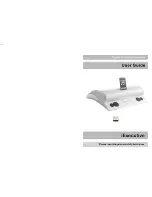
Wall Mounting
• Install the supplied self-stick rubber bumpers to each corner of the speaker’s rear panel. This will
provide clearance between the wall and the cabinet for speaker wire and will prevent the speaker
from marring the wall.
• Cut out the template in the back cover of the owner’s manual to assist in obtaining proper spacing
of the two mounting holes. If the template is not available, space the mounting screws 5
9
/
16
" apart on
a vertical line. Be sure to allow at least 1
3
/
4
" of clearance space above the top screw.
• Check the vertical orientation of the marked hole locations with a torpedo level before drilling.
• Use a #10 or #12 (2
1
/
2
" – 3" long) pan head wood screw mounted into a wall stud.
• Check the fit of the screw head in the keyhole brackets before installation as screw head sizes do vary.
• Drill the proper size pilot hole at the marked positions and install the screws into the wall stud.
Leave the back surface of the screw head protruding about
1
/
4
-inch from the wall surface. This
will facilitate hooking the keyhole bracket over the screw head with the rubber bumpers installed.
The clearance between the wall and the screw head may need to be adjusted to achieve a proper
fit. If a wall stud is not available, use the proper type and weight rating of drywall or masonry anchor
appropriate for the wall construction. Please consult your dealer, custom installer or a building con-
tractor in this situation.
• Do Not Use the Keyhole Mounting Brackets for Ceiling Installations!
How to Connect the Reference Series Speakers
AC POWER / RP-3 AND RP-5 ONLY
Since the RP-3 and RP-5 have internal subwoofer power amplifiers, they must be plugged into a nearby
AC wall outlet. The RP-3 and RP-5 should be unplugged from the AC power with the power switch in
the OFF position during hook up and installation. To eliminate a tripping hazard, all connections
should be unplugged from the back panel if the speaker is being moved. Avoid extremely long extension
cords of small gauge since they can impair the performance of the subwoofer amplifier and present a
potential fire hazard. If the RP-3 or RP-5 will not be used for an extended period of time, unplug the
power cord from the AC power outlet.
Note: 230 volt models are not supplied with an AC power cord but are equipped with an IEC-type
power cord socket.
CAUTION! Since the Klipsch RP-3 and RP-5 have built-in electronics, do not place them near sources
of heat or moisture. Take care to route the power cord so that it will not be cut, damaged or pinched.
SPEAKER WIRE CONNECTIONS
Switch your electronics OFF when making all connections! When making any type of speaker wire
connection, be sure to observe proper polarity (+ to + and - to -). Most speaker wire is insulated, two
conductor, stranded construction and is color-coded or has some distinguishing feature differentiating
the two conductors. Speaker wire connectors on most loudspeakers and amplifiers are also color-coded.
Typically, RED is positive (+) and BLACK is negative (-), or ground. It does not matter which conductor
is connected to the positive or negative terminals of your equipment as long as you are consistent. Be
sure that the connections from all of the amplifier channels to all of the speakers in your system are con-
nected in a like manner. If not, the quantity of bass will be reduced and the stereo image will be compro-
mised. Be careful to avoid excess bare wire or loose strands of wire at the connections. This could cause
a short between adjacent positive and negative terminals, damaging your amplifier. Eighteen gauge
(AWG) wire is the minimum size recommended for short distances with larger gauges recommended for
longer runs. Consult your Klipsch dealer for specific suggestions.
RB-5, RF-3, RP-3 and RP-5: Connect to “Front” or “Main” channel speaker outputs of your system’s
power amplifier (speaker wire connections are the primary type of hookup for the RP-3 and RP-5). With
the gold coupling straps in place, either the UPPER or LOWER binding posts may be used. All of these
models are bi-wire capable for improved clarity and detail (gold metal coupling straps removed). The
low and high frequency sections of the speaker may now be driven with discrete runs of speaker cable
connected to the same channel of your power amplifier. Consult your dealer for more detail about con-
necting two sets of speaker cable to the same channel of your amplifier.
RC-3: Connect to the “Center” channel speaker output of your system’s power amplifier. This model is
also bi-wire capable, see above for more detail.
!






























